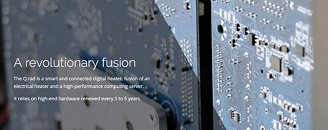Raevenlord
News Editor
- Joined
- Aug 12, 2016
- Messages
- 3,755 (1.21/day)
- Location
- Portugal
| System Name | The Ryzening |
|---|---|
| Processor | AMD Ryzen 9 5900X |
| Motherboard | MSI X570 MAG TOMAHAWK |
| Cooling | Lian Li Galahad 360mm AIO |
| Memory | 32 GB G.Skill Trident Z F4-3733 (4x 8 GB) |
| Video Card(s) | Gigabyte RTX 3070 Ti |
| Storage | Boot: Transcend MTE220S 2TB, Kintson A2000 1TB, Seagate Firewolf Pro 14 TB |
| Display(s) | Acer Nitro VG270UP (1440p 144 Hz IPS) |
| Case | Lian Li O11DX Dynamic White |
| Audio Device(s) | iFi Audio Zen DAC |
| Power Supply | Seasonic Focus+ 750 W |
| Mouse | Cooler Master Masterkeys Lite L |
| Keyboard | Cooler Master Masterkeys Lite L |
| Software | Windows 10 x64 |
Update: Qarnot has updated their page with AMD Ryzen 7 support for its 3 computing units, so it's not limited to Intel offerings. You can see the before and after screenshots on the bottom of this article.
In a move that is sure to bring the cozy, homely warm feeling back towards the space heater concept of yore - who doesn't remember AMD's mocking videos of NVIDIA's Fermi architecture - french company Qarnot has announced their third-generation iteration of a product which is sure to change the Kelvin and Celsius degrees in the computing space. The French company has decided to not let go to waste the (until now) waste heat generated by computing hardware on execution of workloads, and has instead decided to capitalize on those "wasted", byproduct degrees as means of reducing company's and users' heat bills. Their Q.rad concept takes what is usually seen as a drawback in hardware (the amount of waste heat it generates) and turns it into a net positive, by making sure that the heat generated is put to good use in increasing the otherwise chilly temperatures you might be facing.



Their Q.rad sensor makes use of three cloud-enabled Intel Core i7 processors @ 4 GHz frequency - perhaps Ryzen didn't make the cut since it is comparatively more energy efficient per core - as a way of building computing blocks that double as radiators. As Qarnot crunches data (typically, 3D rendering and VFX for film studios), its Q.rad provides up to 500 W "soft heating power" to your home. Reusing heat in such a manner reduces Qarnot's carbon footprint and provides free heating for homes and offices, and also reduces Qarnot's server space overhead, so both parties benefit. This is basically a company thinking outside the box at an old problem, and figuring out an elegant, Columbus-egg-type solution that is obvious, but hadn't been thought of yet.


Basically, the company is asking you to lend them the space that you would be using for a heater anyway, by allowing them to set up a Q.rad in your home. This means that the company needs less space for its server infrastructure, cuts down cooling costs for its cloud computing hardware, and offers you free 500 W of heating power. Electricity costs of the Q.rad's operation are taken into account by an integrated counter, which calculates energy expenses and refunds them to the host. This is the kind of out-of-the-box thinking that allows companies to grow into previously unheard-of spaces and opens up new doors for distributed computing - or is it?



View at TechPowerUp Main Site
In a move that is sure to bring the cozy, homely warm feeling back towards the space heater concept of yore - who doesn't remember AMD's mocking videos of NVIDIA's Fermi architecture - french company Qarnot has announced their third-generation iteration of a product which is sure to change the Kelvin and Celsius degrees in the computing space. The French company has decided to not let go to waste the (until now) waste heat generated by computing hardware on execution of workloads, and has instead decided to capitalize on those "wasted", byproduct degrees as means of reducing company's and users' heat bills. Their Q.rad concept takes what is usually seen as a drawback in hardware (the amount of waste heat it generates) and turns it into a net positive, by making sure that the heat generated is put to good use in increasing the otherwise chilly temperatures you might be facing.



Their Q.rad sensor makes use of three cloud-enabled Intel Core i7 processors @ 4 GHz frequency - perhaps Ryzen didn't make the cut since it is comparatively more energy efficient per core - as a way of building computing blocks that double as radiators. As Qarnot crunches data (typically, 3D rendering and VFX for film studios), its Q.rad provides up to 500 W "soft heating power" to your home. Reusing heat in such a manner reduces Qarnot's carbon footprint and provides free heating for homes and offices, and also reduces Qarnot's server space overhead, so both parties benefit. This is basically a company thinking outside the box at an old problem, and figuring out an elegant, Columbus-egg-type solution that is obvious, but hadn't been thought of yet.


Basically, the company is asking you to lend them the space that you would be using for a heater anyway, by allowing them to set up a Q.rad in your home. This means that the company needs less space for its server infrastructure, cuts down cooling costs for its cloud computing hardware, and offers you free 500 W of heating power. Electricity costs of the Q.rad's operation are taken into account by an integrated counter, which calculates energy expenses and refunds them to the host. This is the kind of out-of-the-box thinking that allows companies to grow into previously unheard-of spaces and opens up new doors for distributed computing - or is it?



View at TechPowerUp Main Site
Last edited:




